ce left ports, extending the miraculous achievements of the rice grain in 2020. From the meaningful hunger-saving rice pots launched by President Ho Chi Minh during the nation’s most difficult days in the past, up until now, Vietnamese rice has had an epic journey, confidently affirming its name on the international market.
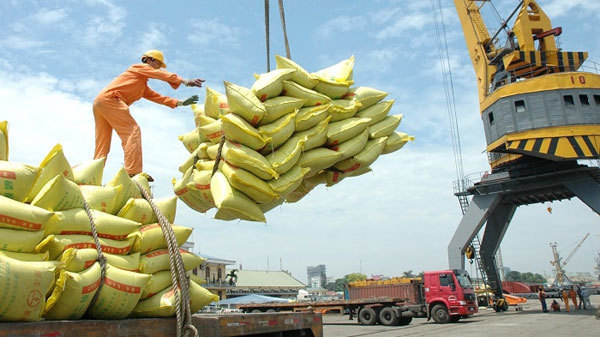 |
Great power comes from a small grain of rice
On January 26, Vinaseed's shipment of 60 tonnes of premium fragrant rice, imported by Longdan in the UK, hit the shelves of the supermarket chain with a retail price of up to £15.5 (VND465,000) per 10 kg. Longdan is the first enterprise to import rice from Vietnam after the UK - Vietnam Free Trade Agreement (UKVFTA) took effect. In the near future, there will be many enterprises importing Vietnamese rice under the agreement.
Previously, on January 13, the first batch of 1,600 tonnes of rice, opening the 2021 export season of the Trung An Hi-tech Farming Joint Stock Company, was sent to Singapore and Malaysia at a price that could not be better, of up to US$750 per tonne.
Pham Thai Binh, Director General of Trung An Hi-Tech Farming JSC, said the two types of rice exported in the shipment were Jasmine 85 fragrant rice and Huong Lai fragrant rice; of which, 450 tonnes of Jasmine 85 went to Singapore at US$680 per tonne and 1,150 tonnes of Huong Lai fragrant rice delivered to customers in Malaysia for US$750 a tonne. In addition to the above shipment, Trung An JSC also had an order of more than 2,000 tonnes exported to Germany, continuing to make effective use of the EU-Vietnam Free Trade Agreement that took effect last year.
Those are the two shipments that successfully opened the new year for Vietnamese rice, with an expectation of more miracles in 2021 than the previous year. Rice exports in 2020 reached about 6.15 million tonnes, worth US$3.07 billion. Although rice exports decreased by about 3.5% compared to 2019, mainly to ensure national food security, export value increased by 9.3%. The average export price for the whole year is estimated to have been US$499 a tonne, an increase of 13.3% compared to 2019. Vietnamese rice prices have surpassed Thailand, rice has become a prized agricultural commodity with positive growth and is constantly being prioritised in the world market.
Looking at the achievements that "Vietnamese pearls" have achieved in the past year, perhaps many people recall the difficult time in the past just after the successful August Revolution in 1945. At that time, rice also held the most important position in the economy. The new Vietnamese government and the young state had to face many invisible "enemies", namely hunger, illiteracy and an empty treasury, as well as enemies both inside and outside the country that threatened the survival of the nation.
Immediately after reading the Declaration of Independence, at the first session of the Provisional Government of the Democratic Republic of Vietnam on September 3, 1945, President Ho Chi Minh raised six urgent issues. According to him, the most important thing was to launch a movement to increase production to fight hunger and immediately open a rice donation campaign to help the poor. “Every ten days, all of our compatriots fast for one meal. The saved rice will be distributed to the poor.” The rice grain at that time was more precious than both pearls and gemstones.
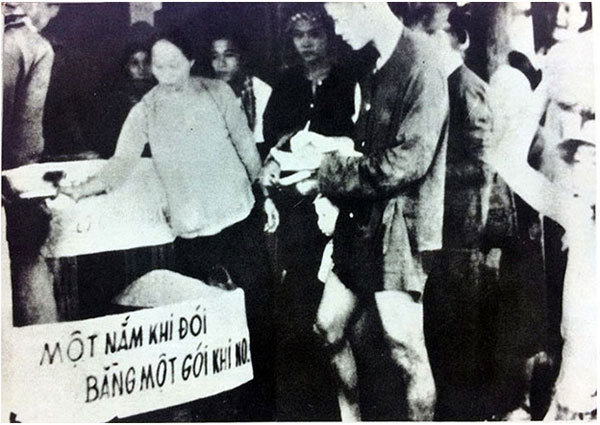 |
| Responding to President Ho Chi Minh's call, Vietnamese donate rice to fight against “the enemy of hunger”. |
From President Ho Chi Minh’s call, the Viet Minh Front and hunger relief organisations mobilised rice donations and organised fasting to set up a "hunger-saving rice jar" model, making it a mass movement. In Thai Binh Province, where the famine was its most severe, the hunger relief movement progressed strongly, attracting a large number of teachers, youngsters and civil servants. Every afternoon, they donated rice, firewood and pots, then cooked the rice and handed it to the hungry. The Hunger Relief Fund raised 30 tonnes of paddy, while Imperial Commissioner to Tonkin Phan Ke Toai contributed 100 tonnes. In addition, the Viet Minh also organised many robberies of Japanese barns and paddy boats. The fine tradition of mutual aid in the nation was reinforced.
In addition, the Government also issued policies and measures such as banning the use of rice for wine making, removing all restrictions on rice circulation among regions, prohibiting people from hoarding rice and establishing a government "supreme committee for supplies and relief". The transportation of rice from provinces in the South and Central Vietnam to the North was quickly carried out in order to bring rice to localities in need of hunger relief. With the spirit of mutual aid, plus the positive measures of the government, the rice grains of gratitude and the power of national unity finally quenched the famine of 1945.
Affirming the Vietnamese brand
76 years have passed since these unforgettable historical days. The small rice grain that went through the country’s ups and downs in the past now accompanies the national journey of strong international integration. In the past five years, Vietnamese rice has increasingly established its brand name on the international market, continuously ranked among the leaders at the World's Best Rice contests (Thien Long Rice in 2015 and ST 24 in 2017), of which, in 2019, ST 25 rice won the title of World's Best Rice. This title affirms that Vietnam has passed the period of focusing on volume in rice exports, moving more towards the export of high quality rice. Agricultural experts have expressed their belief that, if the brand is consolidated with a methodical and long-term plan for production and export, Vietnamese rice can set the world rice price.
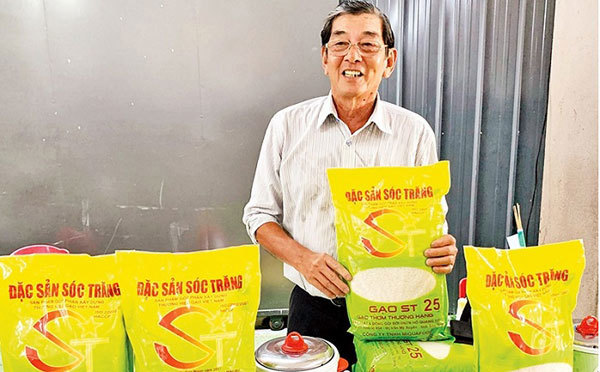 |
| Agricultural engineer Ho Quang Cua and his world's best rice - ST25. Photo: Huu Duc/NDO |
Currently, agricultural engineers are continuing to cultivate ST26, the next line of the world's best rice with its own advantages that promises to bring new achievements.
According to forecasts from the Vietnam Food Association (VFA), rice exports in 2021 will still be good because demand for food continues to increase as Vietnam's main export markets such as the Philippines, Southeast Asian countries and Africa continue to sign rice purchase contracts with Vietnam.
“The Asian rice market has also started to heat up again when a series of potential customers having urgently bought in, of which it is worth mentioning China and Bangladesh. Many other countries also have a great demand for fragrant and sticky rice, an advantageous commodity of Vietnamese enterprises,” VFA Vice President Do Ha Nam said.
Vietnamese rice also has more opportunities to export to some markets where Vietnam has just signed new FTAs. Specifically, within the framework of the Vietnam - Eurasian Economic Union (EAEU) Free Trade Agreement, countries within this bloc have committed to setting aside 10,000 tonnes of tariff-rate quota Vietnamese rice in 2021. With the conclusion of the UKVFTA negotiations, Vietnamese rice exports to the UK will see zero tax and no quota limits.
From the days of starvation to these days of optimism as the country has deeply integrated into the world, a small grain of rice is writing new historical milestones with the country, worthy of its “golden grain” value.
Nhan Dan
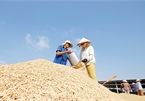
Stage set for scale-up of nation’s rice
Vietnam’s rice processing and trading have overcome the difficulties caused by the ongoing pandemic to acquire the export turnover of over $3 billion in 2020, a record in the past nine years, with exporters remaining bullish over future prospects.
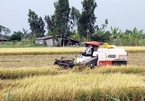
Mekong Delta farmers get bumper harvest, high prices for winter-spring rice
Farmers in the Cuu Long (Mekong) Delta, the country’s rice granary, are having a bumper winter-spring harvest and getting high prices for their grain.